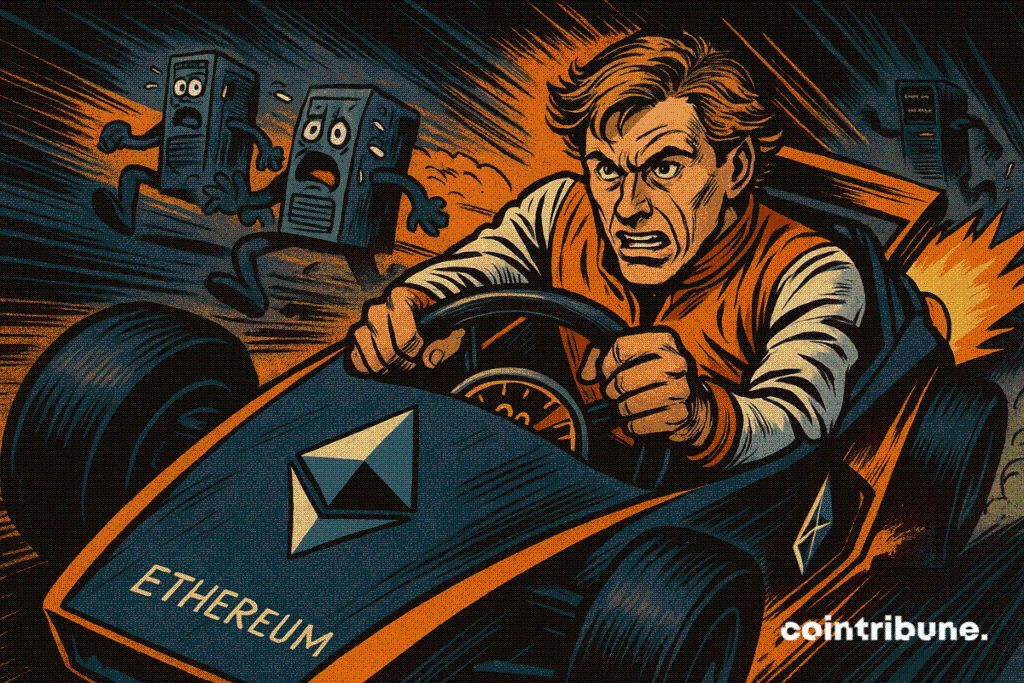3 Major Risks If Ethereum Continues To Increase Its Gas Limit
As ETH gently hovers around $3,800, eyes are blazing towards a symbolic threshold: $4,000. But in the shadow of the price, Ethereum, the reigning smart contract blockchain, is undergoing a deeper transformation. The gas limit, the invisible ceiling that regulates the load of each block, is climbing. A technical advancement praised by Vitalik Buterin himself, but one that divides opinions. For if the engine gains power, the fragile pieces might just break.

In Brief
- Ethereum’s gas limit rises to 39 million, with 50% of validators voting for 45 million.
- Archived nodes shrink from 20 TB to 1.9 TB thanks to Geth v1.16.0.
- Small validators risk exclusion due to lack of technical resources to keep up with this power increase.
- The community worries about a fast Ethereum, but one less accessible to all.
Ethereum pushes its limits… but how far can it go without breaking?
On X, Vitalik Buterin set the tone: “Almost exactly 50% of stakes are voting to increase the L1 gas limit to 45 million. The limit has already started to rise, it is now at 37.3 million.”
The idea? Process more transactions in each block, roughly every 12 seconds. The dream of a fast and smooth blockchain. But this power increase is not without consequences.
On the technical side, Geth optimization, Ethereum’s dominant client, changes the game. Its new version allows archive nodes to reduce storage from 20 TB to 1.9 TB. A real leap. Vitalik praised it :
Here is an example of the recent hard work by the Geth team that makes these load increases safe.
But not everyone is reassured. One user warns : “Is this really scaling, or are we just turning the heat up full blast hoping the kitchen doesn’t burn down?“
The gas limit acts as a slider between performance and accessibility. If pushed too fast, small validators risk being pushed out. The blockchain would then become a private club, far from its decentralization ideals.
Performance increases, but at what cost for the blockchain’s small nodes?
Increasing the gas limit opens the way to a more powerful Ethereum. But it also implies:
- 37.3 million: current gas limit, up from 36 million last May;
- 45 million: target threshold for nearly half the validators;
- 50%: share of staking favorable to this increase;
- 1.9 TB: size of Geth v1.16.0 archive nodes (down from more than 20 TB previously);
- 54%: current market share of Geth on the Ethereum network.
Efficiency is rising, yes. But some see a risk for the open blockchain: with more volume per block, synchronization becomes heavier. Small operators, without solid infrastructures, might drop out.
For now, the increase remains gradual: each block can only raise the limit by 0.1%. A cautious strategy assumed. But a performant blockchain is not enough if it is no longer truly decentralized.
Buterin’s choice is clear: move forward, but with the right tools. His bet relies on alignment between client innovations and block load increases. Provided the community follows and the ecosystem maintains its balance.
Ethereum traces an ambitious path. Increasing the gas limit is just one step in a broader plan: to multiply Layer 1 power tenfold. This 10x Ethereum envisioned by Vitalik Buterin is more than a slogan. It is an ideological and technical challenge, a race against slowness, but also against centralization. The destination is beautiful. The only question is whether everyone can board.
Disclaimer: The content of this article solely reflects the author's opinion and does not represent the platform in any capacity. This article is not intended to serve as a reference for making investment decisions.
You may also like
$8.8 billion outflow countdown: MSTR is becoming the abandoned child of global index funds
The final result will be revealed on January 15, 2026, and the market has already started to vote with its feet.

Deconstructing DAT: Beyond mNAV, How to Identify "Real vs. Fake HODLing"?
There is only one iron rule for investing in DAT: ignore premium bubbles and only invest in those with a genuine flywheel of continuously increasing "crypto per share."

Empowered by AI Avatars, How Does TwinX Create Immersive Interaction and a Value Closed Loop?
1. **Challenges in the Creator Economy**: Web2 content platforms suffer from issues such as opaque algorithms, non-transparent distribution, unclear commission rates, and high costs for fan migration, making it difficult for creators to control their own data and earnings. 2. **Integration of AI and Web3**: The development of AI technology, especially AI Avatar technology, combined with Web3's exploration of the creator economy, offers new solutions aimed at breaking the control of centralized platforms and reconstructing content production and value distribution. 3. **Positioning of the TwinX Platform**: TwinX is an AI-driven Web3 short video social platform that aims to reconstruct content, interaction, and value distribution through AI avatars, immersive interactions, and a decentralized value system, enabling creators to own their data and income. 4. **Core Features of TwinX**: These include AI avatar technology, which allows creators to generate a learnable, configurable, and sustainably operable "second persona", as well as a closed-loop commercialization pathway that integrates content creation, interaction, and monetization. 5. **Web3 Characteristics**: TwinX embodies the assetization and co-governance features of Web3. It utilizes blockchain to confirm and record interactive behaviors, turning user activities into traceable assets, and enables participants to engage in platform governance through tokens, thus integrating the creator economy with community governance.

Aster CEO explains in detail the vision of Aster privacy L1 chain, reshaping the decentralized trading experience
Aster is set to launch a privacy-focused Layer 1 (L1) public chain, along with detailed plans for token empowerment, global market expansion, and liquidity strategies.

